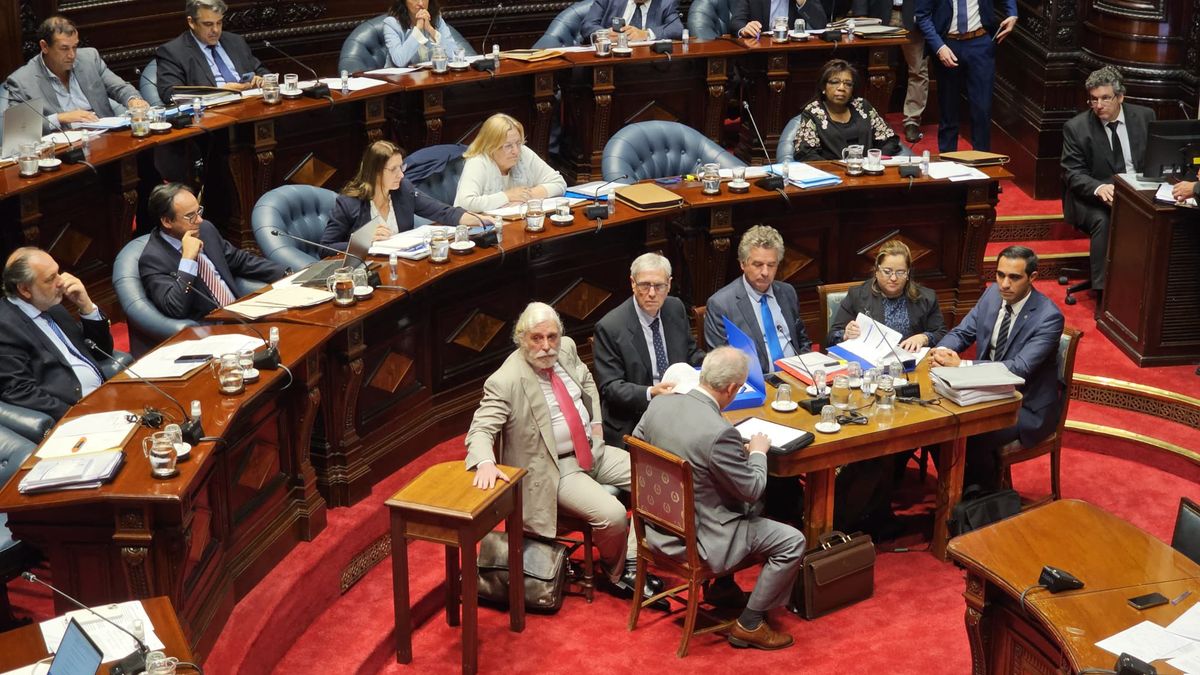From 11, the Chamber of Senators question the ministers of Atmosphere and of Public Health, Robert Bouvier and Karina Rando, respectively, due to the water crisis that Uruguay. The board of directors also appeared National Administration of State Sanitary Works (OSE).
The authorities spoke about the government’s management of the severe water deficit that affects the country, which has led the government to enable the increase in salinity in the water distributed by OSE, going from a limit of 200 mg/L to 400 mg/L of sodium, and from 250 mg/L to 700m mg/L of chloride. This was one of the most controversial measures, and a large part of the reason why ministers and directors were summoned to Parliament. The senator of Broad Front Enrique Rubio He is the one who carried out the interpellation.
Beyond the exhibition no political consequences expectedwhile the official coalition has guaranteed the votes to support Bouvier and Rando, from Colorado Party and of Town meeting, respectively.
Meanwhile, the dam Severine Pass — main source of water supply for the metropolitan area — has record lows of 6.5 million cubic meters, when its approximate ceiling is 65 million. The last time it was full was in November of last year. The government hopes that the forecasted rains and the emergency dam in the Santa Lucia River contribute to shore up a critical situation.
The defense of Robert Bouvier and Karina Rando
During his interpellation, the Minister of the Environment defended the management of Luis Lacalle Pou and the construction project for a water treatment plant in Arazatí, San José, which will take water from the De La Plata river. According to Bouvier, the president decided to “legitimately” divert the road that was intended to build the Casupá dam in Florida.
“We made progress in record time in something that no other government could, which is the plant in San José to take water from the De La Plata river,” explained the minister, who assured that it will be the definitive source of water and the path to solving the problem. future droughts.
On the other hand, he reviewed the actions of the Broad Front during his efforts between 2013 and 2019 and took the opportunity to recriminate that the Casupá plant would be in its final stages – between September of this year and the beginning of 2024 – if they had decided to start with the work, although he admitted that it would not be the solution to the current scarcity problem facing Uruguay.
https://twitter.com/MSPUruguay/status/1658930026274865152
@karinarando: Epidemiological studies show that an intake level between 2.3 and 4.6 g/day of sodium does not increase the risks of cardiovascular events in both healthy and hypertensive individuals. pic.twitter.com/LsehZTkXEK
— MSP – Uruguay (@MSPUruguay) May 17, 2023
For his part, Rando stated: “The water quality guidelines of the World Health Organization (WHO) establish that aspects related to the acceptability of drinking water refer to taste, odor and appearance, although these substances are not have a direct effect on health.
To illustrate her point, the minister explained that 100 grams of potato chips they have the same amount of sodium as seven glasses of water supplied by OSE; a chorizo is equivalent to 12.5 glasses, and 100 grams of nuggets to 7.5 glasses.
For OSE, the only alternative to the increase in salinity is scheduled cuts
In his presentation, the president of OSE explained that “there are not many other alternatives” other than increasing sodium and chloride in the mix. “They can be do scheduled outages; There are cities like San Pablo that made scheduled cuts six or seven years ago. They rotated who they administered to, “she recalled, although she noted that” based on the information out there, interrupting the water service can have serious consequences“.
In addition, the hierarch ratified that “the water consumed by the population is adequately and correctly treated even if the sodium and chloride parameters are not met.” Along these lines, he stated: “The water provided by OSE complies with the norm“. In addition, he reported that “every one or two hours” a control to the water supplied.
Criticism of the Broad Front
During his speech, Rubio —in charge of representing his party during the questioning of the ministers— pointed out that “we would be in a very tough situation for the Uruguayan population” if the expected rains do not occur. In this sense, he considered the need to establish a crisis committee and a national political support tableas long as the management of the water crisis cannot be “just a government issue”.
Also, Senator criticized the official communication around the problem of water and the “ten weeks of silence” in the face of a situation that had already been noticed last November. A question raised by the Frente Amplista was why the agricultural emergency was decreed but not water emergency in parallel, when the first was clearly a consequence of the second.
https://twitter.com/Frente_Amplio/status/1658969383396417538
“Here for some matters there were very prepared people, for other matters there were no people so preparedrather unprepared”, concluded the Frente Amplista senator, in reference, mainly, to the vice president of OSE, Susanna Montaner.
At one point during the session, the climate became even more tense when, in front of the boos by the citizens present to the senator Sergio Botanawhich took its toll on the Broad Front for its management, the vice president Argimón ordered to evict the bars.
The discussion about Casupá in the middle of the interpellation
One of the recriminations of legislator Rubio pointed out that if the government had continued with the Casupá project today there would be a greater amount of reserves. On this, Bouvier replied: “The fact that Casupá was stopped does not determine that it is definitive. Only the priority of the projects was modified, the taking of the Río de la Plata was prioritized.”
The senator Adrian Pena, former Minister of the Environment, ratified that position: “Casupá did not provide a solution to what we needed, because it only solved the problem in Santa Lucía.” A problem that the lobbyist senator was also in charge of underlining Guido Manini Rioswho recalled: “Everyone was aware in 2015 that the Santa Lucía River did not give anymore.”
Montero, from the public company that provides the service, expressed the same sense as his coalition partners. “The project that was in OSE was that of Casupá. I began to study the costs, they did not convince me. The alternatives did not convince me either. Arazati It gives me the solution to three issues,” he said. “We never rule out Casupá but we do understand that we cannot face both things at the same time”he added.
One by one, all the government measures to guarantee drinking water
Yesterday, the government announced new measures to deal with the water crisis in the country and guarantee the availability of running water in the metropolitan area:
- Construction of a dam in Paso Severino: a dam will be built next week that will seek to stabilize the water reserves in Paso Severino, in order to avoid taking new measures, such as increasing salinity in the water, which have a negative impact on its quality.
- Agreement with OSE and the Congress of Mayors to repair losses: The Congress of Mayors agreed to an agreement with OSE to promptly repair any loss of water presented by the pipe networks in the different departments of the country.
- Guaranteed basic supply: the Executive Power reaffirmed its commitment to guarantee the basic supply of running water for cooking, consumption, hygiene, and sanitation.
- Monitoring Bottled Water Prices: The presidential official said that the government will be “monitoring the prices of bottled water” so that they remain within the usual range due to the increase in demand. In turn, he added that the government is testing the importation of water “if necessary.”
- Purchase of a desalination plant designed by UTEC: In an attempt to improve water quality, the government decided to purchase a desalination plant designed by the Technological University of Uruguay (UTEC), which “will surely be operational as of next week.”
- Use of a UTE plant for water distribution: in line with the purchase of the desalination plant designed by UTEC, the Punta del Tigre plant, owned by UTE, will begin to be used, which is “reverse osmosis” and “will be available for water distribution” .
- Enabling of the OSE bagging plant: the OSE bagging plant for sachets of water was enabled, which will be supplied “from those areas or water treatment plants that were made during this period of government”, such as Balneario Argentino, Kiyú, La Floresta, or Pan de Azúcar.
- Mides vouchers for two liters of water: The Ministry of Social Development (Mides) seeks to guarantee a voucher for two liters of water for those who participate in a Mides program for chronic patients, children under two years of age, and pregnant women enrolled in the Equity Plan.
- Distribution of bottled water in the CAIF and INAU centers: The government has provided bottled water to the CAIF and INAU centers throughout the country, in turn, “ANEP is doing it with the 477 schools” in the area, Delgado commented.
Source: Ambito




